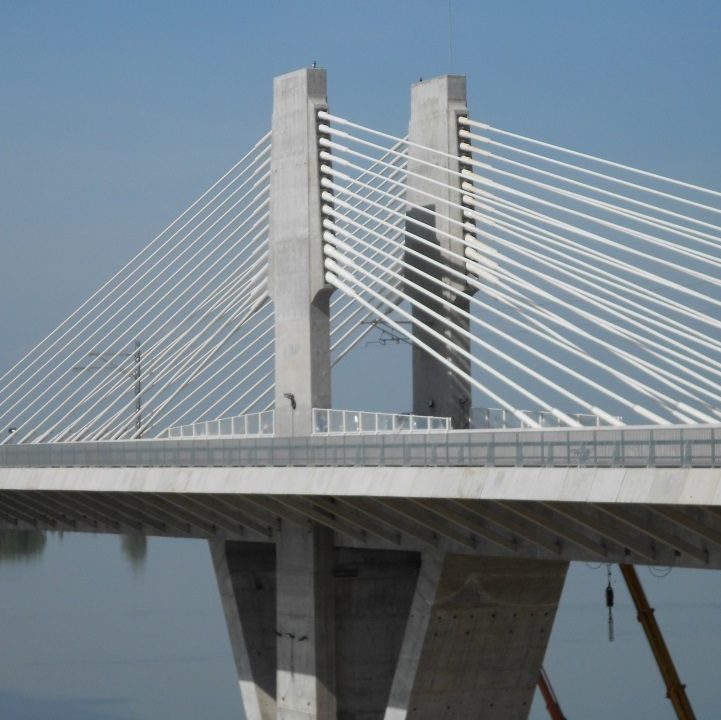The two bridges are located in the Bulgarian-Romanian section of the Danube River.
Danube Bridge Vidin-Calafat

Danube Bridge Vidin-Calafat is a cable-stayed combined road and rail bridge with two lanes, one railroad, bicycle and pedestrian lane. The bridge is located between Vidin (Bulgaria) and Calafat (Romania).It is 1971 meters long. It is made by 300 segments of 120 t everyone and 162 – of 250 tons. The height of the bridge is consistent with the high water of the Danube river and the height of the largest ships, that guarantees their free passage.
Technologically, the bridge structure has been constructed after the method of the cantilever installation, which is done for the fi rst time in Bulgaria, combined with the cable stays.Three hundred segments of width 2, 15 m and weight of about 120 tons form the bridge construction in the non-navigable channel of the river and 162 bigger segments of width 4, 18 m and weight of about 250 tons – in the navigable channel of the Danube. All they were produced in the production plant of FCC Construccion, situated in the Free Zone – Vidin.
The bridge has three parts – one section in the non-navigable channel of the river with 80 m spans, another in the navigable channel of the river with 180 m spans and an approach elevated track with 40 m spans, as their total length is 1971 m. Under the superstructure of the bridge in the non-navigable channel of the Danube are constructed eight piers of height from 3 to 20 meters – depending on the terrain and the slant of the bridge itself. Under each of these piers there are 7 piles with diameter 2 m, at a depth of up to 60 meters. In the navigable channel of the river there are four piers erected, with height from 39 to 45 m. Under each of them there are 24 cast in-situ piles with diameter 2 m at a depth to 80 meters.
It was officially opened for operation on 14 June 2013.


The Designer of the Bridge is ing. Antonio Martinez Cutillas (Spain)

The Danube Bridge Russe-Giurgiu

The Danube Bridge Russe – Giurgiu (formerly known as the Friendship Bridge; Bulgarian: Мост на дружбата, Most na druzhbata or, more commonly, Дунав Mост, Dunav most; Romanian: Podul Prieteniei or Podul de la Giurgiu) is a steel truss bridge over the Danube River connecting the Bulgarian bank to the south with the Romanian bank to the north and the cities of Russe and Giurgiu respectively. It is one of only two bridges connecting Romania and Bulgaria.
The projected bridge on a 1948 stamp Opened on 20 June 1954 and designed by Soviet engineers V. Andreev and N. Rudomazin, the bridge is 2,223.52 m (7,295.0 ft) long and was, at the time, the only bridge over the Danube shared by Bulgaria and Romania, with other traffic being served by ferries and land routes. Decorations were designed by Bulgarian architect Georgi Ovcharov. The bridge has two decks; a two lane motorway and a railway. Sidewalks for pedestrians are also included. The central part of the bridge (85 m) is mobile and can be lifted for oversized boats passage. The maintenance of the mobile part is Romania’s responsibility and is periodically checked. The bridge was constructed in two and a half years with the aid of the Soviet Union.
The Soviets named it the “Friendship Bridge”, but, since the fall of the communist regimes in both countries, the bridge got the more functional name of Danube Bridge Russe – Giurgiu.
Border control stations are present on the bridge, due to its serving as a border crossing between the two countries. Since January 2007 there is no more customs control and the passport/identity card control is done “on one desk” either by the Bulgarian or the Romanian border police, being an “internal border” within the European Union. Border control will be completely removed when Bulgaria and Romania join the Schengen Agreement.



